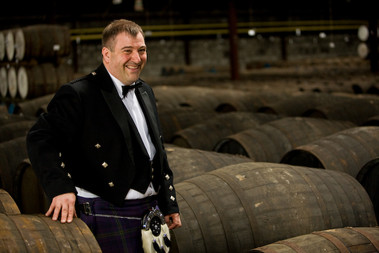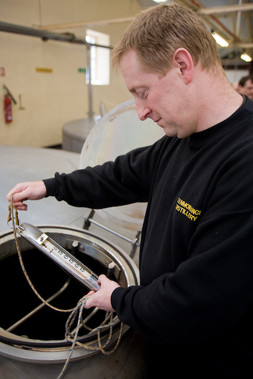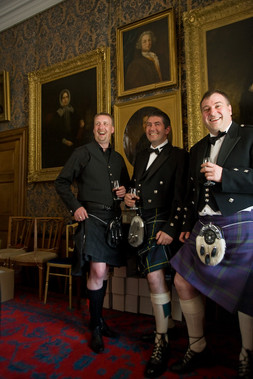Scotch whisky adapts to times but sticks to tradition
July 11, 2008 - Agence France Presse

Gordon Grant walks through the barrels at the Ardmore distillery in Huntly, Aberdeenshire. The change, expansion and consolidation that has characterised the Scotch whisky business over the past few decades has left most distilleries owned by giant corporations. Yet here, creating whisky still borders on religious devotion.
(AFP/File/Joe Ray)
CRAIGELLACHIE, Scotland (AFP) - A spring drive through the Scottish Highlands could melt the frost from the crustiest curmudgeon.
This far north, quiet towns such as Lossiemouth, Craigellachie, Dunkeld and Dufftown are connected by lonely roads that pass through an addictive balm of rolling hills, mountains covered in heather, loud shocks of yellow rapeseed flowers, and, more discreetly, tall pergola roofs that poke up from glens like church spires.
While the latter aren’t exactly churches, they do represent something nearly as vital—they are the quiet and distinct outward hallmarks of Scotland’s whisky industry.
The change, expansion and consolidation that Scotland’s top export has undergone over the past few decades has left most distilleries owned by giant corporations. Yet here, creating whisky still borders on religious devotion.
One of the biggest signs of change is gently moving Scotch whisky away from the cigar-smoking boy’s club image that it has long maintained both inside and outside industry ranks.
“Now that we’re doing so well in the US and Asia, you can have whiskies with a completely different flavour profile,” said Stephanie Macleod, one of the first female master blenders in Scotland and only the seventh master blender (male or female) in the history of Dewar’s, a major brand.
Sure enough, several words she uses to describe the whiskies she creates—honey, floral, vanilla, waxed lemons—are not what one would typically associate with a masculine drink.
“People look for differences in wine and now expect similar things from their whisky,” she says. “People are appreciating flavour more.”
Up on the coast, just outside of the town of Tain, the Glenmorangie distillery has developed a range of whiskies that almost completely eschew the earthy, smoky and even antiseptic characteristics that come from drying barley over a peat fire.
 Mash house operator Jimmy Mackay checks vat temperature at the Glenmorangie distillery near Tain. The change, expansion and consolidation that has characterised the Scotch whisky business over the past few decades has left most distilleries owned by giant corporations. Yet creating whisky still borders on religious devotion.(AFP/File/Joe Ray)
Mash house operator Jimmy Mackay checks vat temperature at the Glenmorangie distillery near Tain. The change, expansion and consolidation that has characterised the Scotch whisky business over the past few decades has left most distilleries owned by giant corporations. Yet creating whisky still borders on religious devotion.(AFP/File/Joe Ray)Bill Lumsden, Glenmorangie’s head of distilling and whisky creation, uses techniques such as aging whiskies in barrels previously used for everything from bourbon to fino sherry and Cote de Nuit.
“The flavour from oak is nice,” he said. “The flavours from Brazilian cherry are not nice—it tastes like marzipan with dishwasher detergent.”
The diversity of product created by aging in different barrels made of different woods for different lengths of time, is appealing to more and more markets around the world. “I go to Asia three or four times a year,” Lumsden said, referring to clients in Singapore, Taiwan, and China. “It’s my second home.”
Two standouts in this vein include The Glenlivet’s 16-year old Nadurra single malt whisky, which is golden in colour (as opposed to a deeper amber colour) thanks to aging in oak casks that contribute smells of vanilla, ginger and dried fruit, especially bananas and orange peel.
The Aberfeldy 21-year-old single malt is almost church-like with waxy, spicy smells, along with heather, honey, orange and vanilla scents.
For Scotch whisky purists, Robert Hicks, master blender for the Ardmore distillery, provides the antidote for those worried the drink is moving away from what they know and love.
His whiskies are peaty affairs that tend to put hair on your chest. But underneath the big flavours are more delicate notes like biscuit, pear, hay, cream and marmalade that give them complexity, something Hicks believes is the result of a very human process.
“Analysis is a good guide,” he says, referring to the growing amount of technology used by the industry as a whole, “but I do it by nose.”
 (L-R) Ardmore distillery manager Alistair Longwell, Laphroaig distillery manager John Campbell and Ardmore support manager Gordon Grant. The change, expansion and consolidation that has characterised the Scotch whisky business over the past few decades has left most distilleries owned by giant corporations. Yet here, creating whisky still borders on religious devotion.(AFP/File/Joe Ray)
(L-R) Ardmore distillery manager Alistair Longwell, Laphroaig distillery manager John Campbell and Ardmore support manager Gordon Grant. The change, expansion and consolidation that has characterised the Scotch whisky business over the past few decades has left most distilleries owned by giant corporations. Yet here, creating whisky still borders on religious devotion.(AFP/File/Joe Ray)
Though most distilleries are now run by large corporations, the soul of the industry seems to have survived intact, with the distilleries still central parts of communities or whole communities to themselves.
John Campbell, manager at the island of Islay’s Laphroaig distillery, has whisky-making in his blood. He grew up only a mile and a half (2.5 kilometres) from where he now works and is the third generation in his family to work for Laphroaig.
“To someone who’s not from Islay, it might be the national drink or a bunch of sales figures,” he says, “but on the island, Scotch whisky is part of the fabric. It’s just life. It just is.”
This article also ran with:
Yahoo News, Silobreaker, IOL, The Smart Set, iAfrica.com, SAWF, France24.